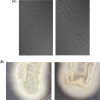The Mould-specific M46 gene is not essential for yeast-mould dimorphism in the pathogenic fungus Histoplasma capsulatum
- PMID: 27335057
- PMCID: PMC5057458
- DOI: 10.1093/mmy/myw040
The Mould-specific M46 gene is not essential for yeast-mould dimorphism in the pathogenic fungus Histoplasma capsulatum
Abstract
Histoplasma capsulatum (Hc) is the causative agent for the respiratory infection histoplasmosis. The fungus exists in the environment as a saprophytic multi-cellular mould. Spores are inhaled by mammals whereupon the organism will convert into the single-celled yeast morphotype resulting in infection. The shift to the yeast morphotype is required for pathogenesis. Most studies on dimorphism have examined yeast-phase-specific genes and few mould-phase-specific genes have been investigated. It is likely, that some mould-phase-specific genes must be downregulated for the yeast to form or upregulated for the mould to form. We isolated a strongly expressed mould-specific gene, M46, from an expression library enriched for mould upregulated genes in Hc strain G186AS. To determine if M46 is involved in dimorphism, M46 was ectopically expressed in yeast phase growing temperature, and an m46 knockout strain was created via allelic replacement. Ectopically expressing M46 in yeast, did not induce filamentous growth. Genomic disruption of M46 by allelic replacement did not alter the morphology of the mould as seen in bright field microscopy, scanning electron microscopy, and transmission electron microscopy. A growth curve study, revealed that M46 is not involved in maintaining the growth rate of cells. These findings indicate that the mould specific M46 gene is not necessary nor essential for dimorphism, maintaining the normal mould morphology, and growth rate of Histoplasma capsulatum.
Keywords: Histoplasma capsulatum; M46; dimorphic; fungus; pathogenic.
© The Author 2016. Published by Oxford University Press on behalf of The International Society for Human and Animal Mycology. All rights reserved. For permissions, please e-mail: journals.permissions@oup.com.
Figures








Similar articles
-
The mold-specific MS8 gene is required for normal hypha formation in the dimorphic pathogenic fungus Histoplasma capsulatum.Eukaryot Cell. 2002 Apr;1(2):249-56. doi: 10.1128/EC.1.2.249-256.2002. Eukaryot Cell. 2002. PMID: 12455959 Free PMC article.
-
Opposing signaling pathways regulate morphology in response to temperature in the fungal pathogen Histoplasma capsulatum.PLoS Biol. 2019 Sep 30;17(9):e3000168. doi: 10.1371/journal.pbio.3000168. eCollection 2019 Sep. PLoS Biol. 2019. Retraction in: PLoS Biol. 2023 Mar 21;21(3):e3002060. doi: 10.1371/journal.pbio.3002060. PMID: 31568523 Free PMC article. Retracted.
-
Characterization of the APSES-family transcriptional regulators of Histoplasma capsulatum.FEMS Yeast Res. 2018 Dec 1;18(8):foy087. doi: 10.1093/femsyr/foy087. FEMS Yeast Res. 2018. PMID: 30101348 Free PMC article.
-
[Dimorphism and pathogenesis of Histoplasma capsulatum].Rev Argent Microbiol. 2006 Oct-Dec;38(4):235-42. Rev Argent Microbiol. 2006. PMID: 17370580 Review. Spanish.
-
Dimorphism in Histoplasma capsulatum: a model for the study of cell differentiation in pathogenic fungi.Microbiol Rev. 1989 Jun;53(2):186-209. doi: 10.1128/mr.53.2.186-209.1989. Microbiol Rev. 1989. PMID: 2666842 Free PMC article. Review.
Cited by
-
Cysteine Dioxygenase Enzyme Activity and Gene Expression in the Dimorphic Pathogenic Fungus Histoplasma capsulatum Is in both the Mold and Yeast Morphotypes and Exhibits Substantial Strain Variation.J Fungi (Basel). 2020 Feb 13;6(1):24. doi: 10.3390/jof6010024. J Fungi (Basel). 2020. PMID: 32069814 Free PMC article.
-
Hemophagocytic Lymphohistiocytosis Secondary to Disseminated Histoplasmosis in HIV Seronegative Patients: A Case Report and Review of the Literature.Front Cell Infect Microbiol. 2022 Jun 16;12:847950. doi: 10.3389/fcimb.2022.847950. eCollection 2022. Front Cell Infect Microbiol. 2022. PMID: 35782129 Free PMC article. Review.
-
Deletion of the Stress Response Gene DDR48 from Histoplasma capsulatum Increases Sensitivity to Oxidative Stress, Increases Susceptibility to Antifungals, and Decreases Fitness in Macrophages.J Fungi (Basel). 2021 Nov 18;7(11):981. doi: 10.3390/jof7110981. J Fungi (Basel). 2021. PMID: 34829268 Free PMC article.
References
-
- Hammerman KJ, Powell KE, Tosh FE. The incidence of hospitalized cases of systemic mycotic infections. Sabouraudia. 1974;12:33–45. - PubMed
-
- Maresca B, Medoff G, Schlessinger D, et al. Regulation of dimorphism in the pathogenic fungus Histoplasma capsulatum. Nature. 1977;266:447–448. - PubMed
-
- Medoff G, Sacco M, Maresca B, et al. Irreversible block of the mycelial to yeast phase transition of H. capsulatum. Science. 1986;231:476–479. - PubMed
MeSH terms
Grants and funding
LinkOut - more resources
Full Text Sources
Other Literature Sources

